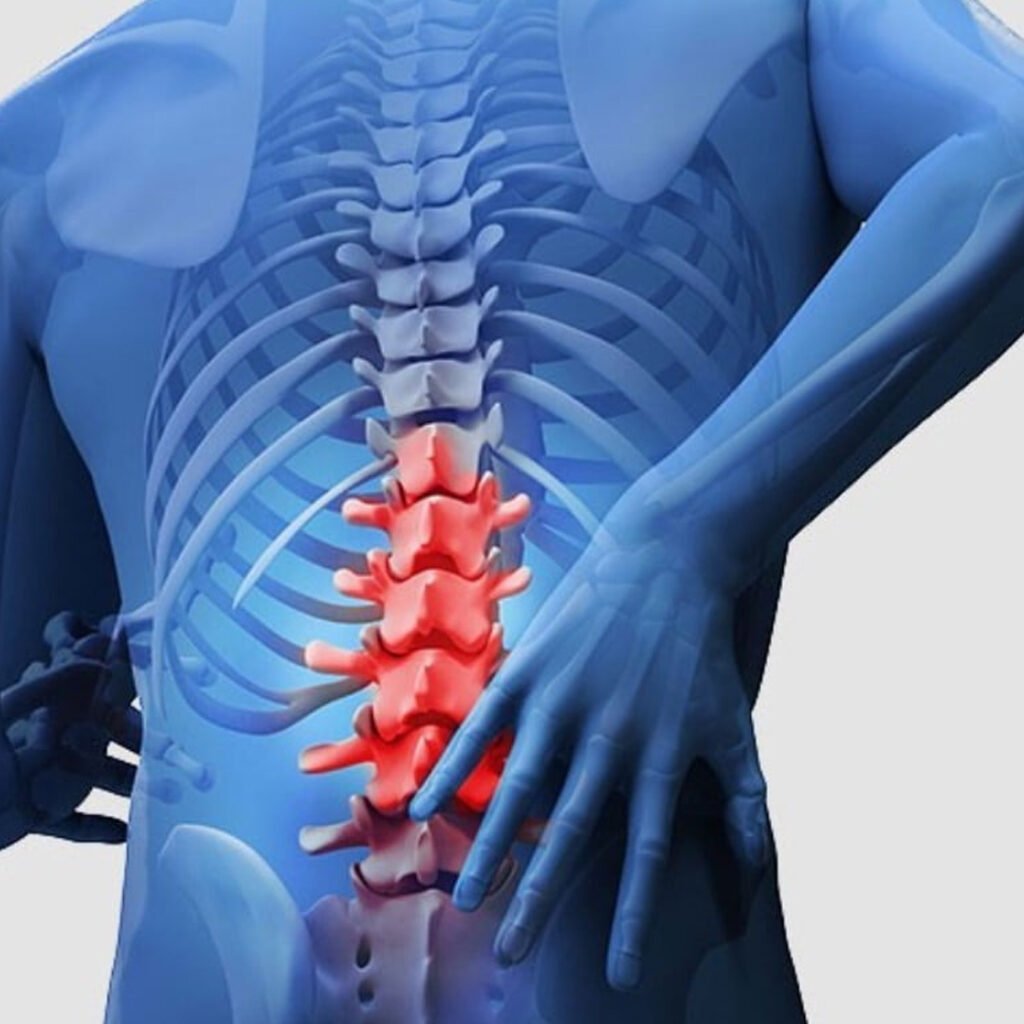Lumbar Spondylosis
Introduction
Lumbar spondylosis is a degenerative condition affecting the lower spine, commonly caused by aging, wear and tear, or injury. It involves the breakdown of spinal discs, joints, and ligaments, leading to stiffness, pain, and reduced flexibility in the lower back. In severe cases, it may compress nearby nerves, causing numbness or weakness in the legs.

Types of Lumbar spondylosis
Disc Degeneration
Intervertebral discs lose flexibility and hydration, reducing cushioning between vertebrae and causing persistent lower back pain.
Facet Joint Osteoarthritis
Facet joints wear out, leading to stiffness, inflammation, and discomfort, especially during movement or prolonged activity.
Spinal canal stenosis
The narrowness of the spinal canal compresses the veins, resulting in back pain, tingling, numbness and leg weakness.
Spondylolisthesis
One vertebra slips forward over another, causing nerve compression, lower back pain, and walking difficulties.
Causes of Lumbar spondylosis:
- Age -related degeneration weakens spinal discs and joints over time.
- The sedentary lifestyle causes hardness and accelerates the spinal cord degeneration process.
- The poor posture continuously stresses the spine of the lower back.
- Heavy lifting causes gradual wear and tears in the spine.
- Last spinal injuries increase the chances of spondylosis development of wood.
- Obesity puts pressure on the spine, the disk accelerates degeneration.
- Genetic causes inspire individuals to the backbone problems of the initial wood.
- Smoking reduces blood flow, affecting spinal disc health badly.
- Calcium deficiency weakens bones, increases the vulnerability of the spine of the wood.
- The disc dehydration reduces cushioning, causing friction between the vertebrae.
Clinical features of Lumbar spondylosis:
Lower Back Pain
Continuous dull or sharp lower back pain worsens with physical activity and prolonged sitting.
Stiffness in Spine
Morning stiffness limits spinal movements, making bending, twisting, and standing extremely uncomfortable.
Nervous compression symptoms
Compressed veins cause tingling, numbness and weakness in the legs, sometimes affecting the ability to walk normal.
Limited range of speed
Low spinal flexibility makes it difficult to perform daily tasks and physical activities.
Radiating Leg Pain
The lower back pain is reduced due to nerve root compression.
Symptoms associated with Lumbar spondylosis:
- Constant low back pain that worsens during movement or physical activity.
- Morning stiffness in the lower spine is difficult to bend and turn.
- There was a numbness or tingling sensation in the feet and feet.
- Muscle weakness in the lower limbs due to nerve compression.
- Radiation of pain that travels from under the back to the feet.
- Difficulty seating for standing, walking or comfortable extended periods.
- Low flexibility and limited range of speed in the spine.
- Sometimes muscle cramps or lower back cramps.
Investigations in Lumbar spondylosis:
- X-rays are usually used to detect bone abnormalities such as bone spars, disk space narrowness, and melignament of vertebrae. They help doctors evaluate degenerative changes and meet fractures or other structural spine problems.
MRI scans offer spinal discs, nerves and softened tissues around the nerves. This disk helps in detecting herniation, nervous compression and degeneration, which provides a clear understanding of the lumbar spondylosis.
CT scans produce extremely wide cross-depleted images of the spine. They are especially useful in identifying bony changes, spinal canal narrowness and structural deformity, when X-rays provide better insight when they fail to give adequate information.
Milography involves injecting a contrast dye in the spinal canal, showing nerve roots and spinal structures on the imaging scan. It is used when MRI or CT results are individual, especially in spondylosis cases of complex lumbar.
EMG measures muscle electrical activity to identify abnormal muscle reactions caused by nerve compression. This probe helps evaluate the degree of nerve damage and effectively separates spondylosis of lumbar from other neuromuscular disorders.
The NCS measures the speed and strength of the electrical signals traveling through peripheral veins. It identifies damage caused by nervous compression, obstructions, or lumbar spondylosis, often performed with EMG for a broad neurological evaluation.
A bone density test assesses bone strength and detects osteoporosis, which may spoil spondylosis of the lumbar. Weak bones increase spinal degeneration risk, making this test important to patients, especially older adults or people with recurrent fractures.
Blood tests help control infection, inflammatory conditions, or autoimmune diseases that can mimic spondylosis symptoms of lumbar. They are especially useful in separating spondylosis from arthritis, effectively, ankyloging spondylitis, or other inflammatory spinal disorders.
Discography involves injecting a contrast dye in the spinal disc to identify damaged or impure discs. This is done when other imaging methods cannot detect the exact source of pain, providing clinical information targeted for treatment.
A wide physical examination assesses asana, spinal flexibility, muscle strength, reflexes and nerve function. Doctors conduct agitation tests to evaluate pain trigger and neurological deficit, which helps determine the severity and progress of spondylosis of the lumbar spondylosis.
